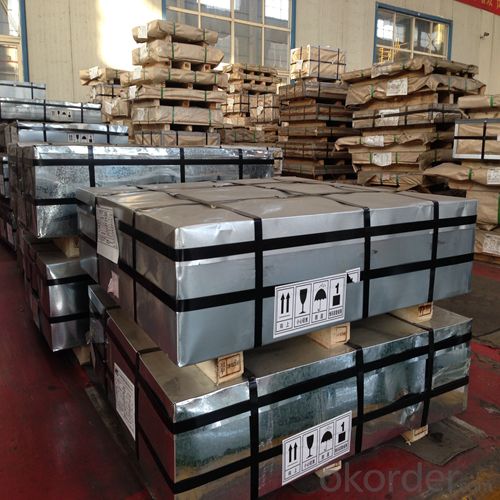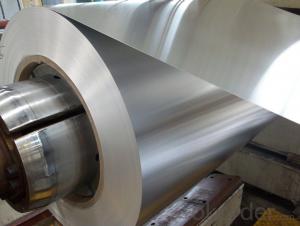Tinplates Coils / Sheet for Foods Packaging
- Loading Port:
- Tianjin
- Payment Terms:
- TT OR LC
- Min Order Qty:
- 25 m.t
- Supply Capability:
- 7000 m.t/month
OKorder Service Pledge
OKorder Financial Service
You Might Also Like
1.Structure of Electrolytic Tin Plate Coils and Sheets for Foods Metal Packaging Description
Electrolytic Tin Plate Coils and Sheets for Foods Metal Packaging, is one thin steel sheet with a coating of tin applied by electrolytic deposition. Tinplate made by this process is essentially a sandwich in which the central core is strip steel. This core is cleaned in a pickling solution and then fed through tanks containing electrolyte, where tin is deposited on both sides. As the strip passes between high-frequency electric induction coils, it is heated so that the tin coating melts and flows to form a lustrous coat.
2.Main Features of the Electrolytic Tin Plate Coils and Sheets for Foods Metal Packaging
Appearance – Electrolytic Tin Plate is characterized by its beautiful metallic luster. Products with various kinds of surface roughness are produced by selecting the surface finish of the substrate steel sheet.
Paintability and printability – Electrolytic Tin Plates have excellent paintability and printability. Printing is beautifully finished using various lacquers and inks.
Formability and strength – Electrolytic Tin Plates have got very good formability and strength. By selecting a proper temper grade, appropriate formability is obtained for different applications as well as the required strength after forming.
Corrosion resistance – Tinplate has got good corrosion resistance. By selecting a proper coating weight, appropriate corrosion resistance is obtained against container contents. Coated items should meet 24 hour 5 % salt spray requirement.
Solderability and weldability – Electrolytic Tin Plates can be joined both by soldering or welding. These properties of tinplate are used for making various types of cans.
Hygienic – Tin coating provides good and non toxic barrier properties to protect food products from impurities, bacteria, moisture, light and odours.
Safe – Tinplate being low weight and high strength makes food cans easy to ship and transport.
Eco friendly – Tinplate offers 100 % recyclability.
Tin is not good for low temperature applications since it changes structure and loses adhesion when exposed to temperatures below – 40 deg C.
3.Electrolytic Tin Plate Coils and Sheets for Foods Metal Packaging Images



4.Electrolytic Tin Plate Coils and Sheets for Foods Metal Packaging Specification
Standard | ISO 11949 -1995, GB/T2520-2000,JIS G3303,ASTM A623, BS EN 10202
|
Material | MR,SPCC |
Thickness | 0.15mm - 0.50mm |
Width | 600mm -1150mm |
Temper | T1-T5 |
Annealing | BA & CA |
Coil Inner Diameter | 508mm |
Weight | 6-10 tons/coil 1~1.7 tons/sheets bundle |
Passivation | 311 |
Oil | DOS |
Surface | Finish,bright,stone,matte,silver |
5.FAQ of Electrolytic Tin Plate Coils and Sheets for Foods Metal Packaging
-What your tinplate material is used for ?
Tinplate is widely used for the packaging of products. Such as food cans,
beverage cans, pet cans, closures, general line cans and so on.
Printed Tinplate is offered!!
-How to place .an order or contact you ?
Please send us Email. we will give you a quick response in seconds .
- How is your quality ?
All our quality is prime even the secondary quality . We have many years experience
In this field with serious quality control standard . Advanced equipment, We welcome your visit to our factory .
- Q:How does tinplate contribute to the containment of chemical substances?
- Tinplate contributes to the containment of chemical substances by providing a protective barrier against corrosion and contamination. It is a durable and impermeable material that prevents the interaction between the chemical substances and the surrounding environment, ensuring their integrity and safety.
- Q:How does the thickness of tinplate affect its strength and durability?
- The thickness of tinplate directly affects its strength and durability. Thicker tinplate tends to be stronger and more durable, as it can withstand greater external forces and resist deformation. Thicker tinplate also offers better protection against corrosion and can handle harsher environmental conditions. On the other hand, thinner tinplate may be more prone to bending or denting, and it may have reduced durability and resistance to damage.
- Q:How does tinplate contribute to the overall aesthetics of packaging?
- Tinplate contributes to the overall aesthetics of packaging by adding a sleek and premium look to products. Its smooth surface and high reflectivity enhance the visual appeal, making the packaging stand out on shelves. Additionally, the ability to print vibrant colors and intricate designs on tinplate further enhances the attractiveness of the packaging, making it visually appealing to consumers.
- Q:What are the considerations for handling and storing tinplate coils?
- Considerations for handling and storing tinplate coils include ensuring proper lifting and handling techniques to prevent damage, maintaining a clean and dry storage area to prevent corrosion, using appropriate protective measures such as wrapping or covering the coils, and implementing a systematic inventory management system to facilitate easy access and rotation of the coils.
- Q:What are the advantages of using tinplate for beverage cans?
- Tinplate offers several advantages for beverage cans, including its excellent resistance to corrosion, its ability to maintain the freshness and taste of the beverage, its high strength-to-weight ratio, its ease of recyclability, and its cost-effectiveness.
- Q:How is tinplate decorated or printed?
- Tinplate is decorated or printed using various techniques such as lithography, offset printing, and metal decorating. These methods involve applying designs, patterns, or images onto the tinplate surface using inks, pigments, or coatings.
- Q:What are the advantages of using tinplate for stationery and office supplies?
- One of the advantages of using tinplate for stationery and office supplies is its durability. Tinplate is known for its resistance to corrosion, making it long-lasting and suitable for items that are frequently used or handled. Additionally, tinplate provides a smooth and glossy surface, enhancing the aesthetic appeal of stationery and office supplies. Its malleability allows for intricate designs, making it suitable for customizations and branding. Lastly, tinplate is a sustainable option as it is recyclable, contributing to eco-friendly practices in the stationery and office supply industry.
- Q:How does tinplate contribute to the performance of sports equipment?
- Tinplate contributes to the performance of sports equipment by providing a durable and lightweight material that is resistant to corrosion. It is commonly used in the manufacturing of cans, containers, and protective coatings for sports equipment, ensuring longevity and enhancing performance. Additionally, tinplate offers excellent adhesion properties, allowing for better grip and control, especially in activities that involve handling equipment such as racquets, bats, or golf clubs.
- Q:How does tinplate perform in terms of puncture resistance?
- Tinplate performs exceptionally well in terms of puncture resistance. Its sturdy and durable properties make tinplate highly resistant to punctures, ensuring the protection and integrity of the packaged contents.
- Q:How is tinplate stored?
- Tinplate is typically stored in a dry, well-ventilated area to prevent moisture and humidity from causing corrosion. It is advisable to stack the tinplate sheets or rolls on pallets or shelves, ensuring they are kept away from direct contact with the ground to avoid damage. Additionally, it is important to protect the tinplate from any potential sources of scratching or denting during storage.
1. Manufacturer Overview |
|
|---|---|
| Location | |
| Year Established | |
| Annual Output Value | |
| Main Markets | |
| Company Certifications | |
2. Manufacturer Certificates |
|
|---|---|
| a) Certification Name | |
| Range | |
| Reference | |
| Validity Period | |
3. Manufacturer Capability |
|
|---|---|
| a)Trade Capacity | |
| Nearest Port | |
| Export Percentage | |
| No.of Employees in Trade Department | |
| Language Spoken: | |
| b)Factory Information | |
| Factory Size: | |
| No. of Production Lines | |
| Contract Manufacturing | |
| Product Price Range | |
Send your message to us
Tinplates Coils / Sheet for Foods Packaging
- Loading Port:
- Tianjin
- Payment Terms:
- TT OR LC
- Min Order Qty:
- 25 m.t
- Supply Capability:
- 7000 m.t/month
OKorder Service Pledge
OKorder Financial Service
Similar products
New products
Hot products
Related keywords




























